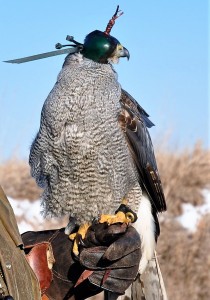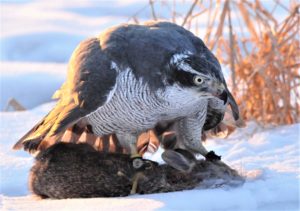Photography courtesy of Lowell Washburn, all rights reserved.
Widespread and abundant, cottontail rabbits are an important component of Iowa’s natural food chain. I’m an active member of that chain. I love finding, chasing, and consuming rabbits. White, light and extremely nutritious, rabbit is one of my favorite entrees. There are lots of ways to pursue cottontails. I’ve hunted them with bow and arrow, .22 rifles, frontier era cap and ball revolvers, and a variety of shotguns. Although all have proven to be enjoyable methods of putting fried rabbit on the dinner table, nothing tops the sheer exhilaration of pursuing cottontails with trained hawks.
Humans have been hunting wild game with trained raptors for around four thousand years now, making falconry one of the oldest methods of obtaining a good hot meal. This winter, I’ve been chasing rabbits with a pair of northern goshawks that I call Atilla and Mayhem. Atilla is a spirited tenth season male. Together we’ve hunted everything from mallard ducks to ring-necked pheasants to snowshoe hare. A few seasons back, he even caught a hen turkey – an amazing feat for a hawk weighing in at a mere 28 ½ ounces.
The bird I call Mayhem is a third season female captured near the Canadian border during her first migration. A large bird with a with a bone crushing grip and tin snip beak, she initially was one of the wildest hawks I’d ever handled. Today, she continues to become more reliable with each trip to the field.
Winged hunters of the deep forest, goshawks are famed for their tenacious pursuit of game and the ability to conduct warp speed maneuvers in tight cover. But that doesn’t mean that our hunts are not without challenge. Hawks and rabbits have been sharing the same habitats for eons. Whenever the age-old contest begins, the rabbit may well live to hop another day.
This late-season outing provided a classic example. Carrying Atilla on my gloved fist, we had barely began making our way into some tall grass when the goshawk suddenly exploded into action. Blasting from the glove, his swiftly accelerating straightaway flight was low and direct. I soon detected the object of the hawk’s attention; a bouncing white dot that is the trademark signature of a departing cottontail.
Instead of giving us the close-range flush I had hoped for, the rabbit had launched its high-speed getaway from a distance of forty yards. No surprise, really. It was, after all, the end of February. By this stage of the game, all the easy rabbits are long gone. After months of evading everything from coyotes and fox to hawks by day and owls by night, season hardened veterans are all that’s left. Street smart survivors, they’re the best of the best. When hunting late season cottontails, I’ve found that it’s wise to have a backup plan for supper.
Back to the Chase: In spite of the rabbit’s big head start, the goshawk’s rapidly whirring wings quickly closed the gap. Within seconds, the hawk was on the rabbit’s tail. Shifting tactics, the fleeing bunny began a series of high-speed, zig jagging maneuvers. Mimicking each erratic move, the shadowing hawk was soon within inches of its prize. The rabbit appeared doomed until, at a fraction of the very last second, it reached the lifesaving refuge of an impenetrable wall of seven-foot-tall marsh willow and dogwood. Launching a final spectacular leap, the cottontail vanished into the dense tangle.
With the rabbit lost to view; the chase was over. Using current momentum to its fullest advantage, the raptor avoided collision by shooting up and over the willows. The flight ended with the raptor posting in the branches of a nearby cottonwood. Anticipating an easier hunt, I had left the dog at home. Big mistake. With the perched hawk now staring intently into the gigantic patch of intertwined grasses and woody vegetation, it suddenly became my duty to crawl in and put the cottontail to route. Unfortunately, my nose is not nearly as keen as the dog’s. And although I made my very best effort, the rabbit – wherever it was hiding – failed to budge. It was a fruitless search and I finally gave up. Emerging from the tangle, it was time to move on.
Walking the remaining cover to its end, we failed to locate more rabbits and eventually returned to the truck. Rabbits: One. Hawks & Humans: Zero. Like I said, when pursuing late season cottontails it is always a good idea to have an alternate plan for supper.
Deciding to switch habitats and give the female a try, I put Attila back on his car perch and headed for a nearby woodland where more snow cover and lighter understory might aid in success. Carrying the ‘gos a short way into the woods, I removed her hood and our hunt began. After riding the glove for a few minutes but seeing no game, the bird grew impatient and flew to a tree where the elevated perch would provide a better view.
As I continued through the woodland, a single rabbit was finally put to route. Wasting no time, the cottontail was really pouring on the coals, crossing the woodlot in spectacular six-foot leaps. [I know they were literal six-foot bounds because I measured the tracks after the hunt and then took pictures.] Although I couldn’t see the hawk, the sound of her bells told me she was on the way. As I continued to watch the exiting Olympic grade cottontail, the goshawk made her anticipated appearance. Coming in from the side, the big hawk was giving it all she had. The rabbit attempted a last-minute sideways dodge, but the effort was too little too late. The hawk connected, and the chase ended in a dramatic flurry of fur, feathers, and snow.
Taking a seat atop a fallen log, I let the goshawk enjoy her reward. After consuming a good portion of the rabbit’s front quarter, the hawk stepped back onto the glove to finish her meal with meat obtained from my hunting bag. The remainder of the cottontail was quietly slipped into the game pocket. White, light, and extremely nutritious, I’ll take all the fried rabbit I can get.



 Tom Cope
Tom Cope Sue Wilkinson
Sue Wilkinson Susan Judkins Josten
Susan Judkins Josten Rudi Roeslein
Rudi Roeslein Elyssa McFarland
Elyssa McFarland Mark Langgin
Mark Langgin Adam Janke
Adam Janke Joe Henry
Joe Henry Kristin Ashenbrenner
Kristin Ashenbrenner Joe Wilkinson
Joe Wilkinson Dr. Tammy Mildenstein
Dr. Tammy Mildenstein Sean McMahon
Sean McMahon